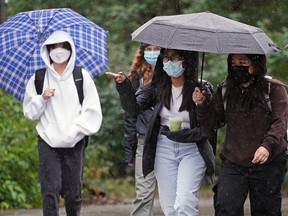Opinion: Lost educational days and other long-term harms are putting pressure on this generation, impacting their well-being and academic success.

Canada’s post-secondary institutions have a responsibility to protect students and others on campus from the risks of post-COVID condition as a matter of campus safety.
Post-COVID condition (PCC), also known as “long COVID,” refers to the poorly understood and often serious health damage left by the SARS-CoV-2 virus after the acute illness appears to have passed.
Universities, colleges and schools have a duty to take reasonable precautions to protect students, staff and faculty from foreseeable harms. They must ensure the water on campus is safe to drink. They must install fire and carbon monoxide detectors and make evacuation plans. Many have adopted a smoke-free policy on campus as part of a commitment to an international charter on health promotion in universities and colleges.
Yet there is little pandemic health promotion on Canadian campuses.
As with any other pathogen (or smoke, for that matter), if it can’t get into your body, then it can’t make you sick. The chief science adviser’s report recognizes the vital importance of reducing PCC cases by reducing infections.
University students particularly vulnerable
A COVID-19 infection can be the tip of a very large iceberg. A Statistics Canada report last year indicated that Canadians have lost millions of school and work days because of PCC. PCC has a long list of possible symptoms, including negative effects on brain functioning and mental health, as well as cardiovascular and lung health.
The chief science adviser’s report notes that “with each SARS-CoV-2 reinfection, the risk of developing PCC is cumulative.”
Post-secondary students are particularly vulnerable to repeated COVID infections because of shared living spaces (dorms, student housing) and front-line work (waiting tables and retail jobs, for instance), and transmission can be boosted by extensive mixing due to complex timetables and crowded spaces on campuses.
While we lack specific data on sick days and long COVID cases at the post-secondary level in Canada, national data suggests over 40 per cent of Canadians were infected over a three-month period last winter. There are about two million post-secondary students in Canada.
Post-secondary students are inevitably affected by the multiple surges in infections each year, and so are losing days to acute COVID illness.
And, with each infection, they’re at increased risk of PCC. This is key to understanding the pandemic’s continuing disruptions to education and well-being for the current generation of college and university students.
A study of U.S. university students with PCC noted symptoms such as “difficulty thinking, fatigue, feeling anxious” and “memory loss,” consequential for academic performance and overall well-being.
Reducing infections
We have abundant high-quality, peer reviewed scholarship from a range of disciplines to help us reduce infections. Building on this evidence base, the chief science adviser’s report calls for “protective measures through steps that government, institutions and employers can take.”
These protections include “improved indoor air quality,” better “public messaging” and “effective masking in crowded spaces.”
Improving indoor air quality includes increasing ventilation rates, adding high quality filters to the air handling systems, the use of portable air filtration units, germicidal ultraviolet lights, and the monitoring and public display of carbon dioxide levels in all living and learning spaces on campus.
Improving indoor air quality has been shown to reduce in-classroom transmission of COVID by at least 80 per cent in schools.
Free N95 masks and updated vaccinations should also be made available, and their use promoted on campuses to improve awareness and access. Communications should educate students on reducing their risk. Drawing on faculty expertise from all disciplines, and with little financial cost, post-secondary institutions can implement and model best practices on all of these fronts.
Organized, evidence-informed efforts are also urgently needed to accommodate students whose coursework has been significantly affected by infection or PCC. PCC includes a wide range of symptoms at varying levels of severity, so no cookie-cutter approach will work well.
The Pandemic’s continuing effects
Institutions lack even the most basic data about PCC on campus. How many people on campus are already affected by PCC and to what degree? How many are on extended leave or had to withdraw or resign because of it?
Trans-disciplinary faculty and student expertise and lived experience can help institutions to understand the pandemic’s continuing effects. This is a necessary step to the development of more inclusive and effective approaches to mitigating the harms of the pandemic.
Without efforts to reduce students’ risk of getting sick — and to meaningfully help them when they do — we can only expect more population-level problems with well-being, continuing health-care needs and academic success.
These effects have the potential to ripple into the general workforce, adding to population and economic consequences. While the pace of research on COVID has been and continues to be fast, new discoveries will not erase the lost educational days and other long-term harms that are already putting pressure on this generation.
The burden of PCC and the pandemic will shape the next half century, and it’s in everyone’s interest that our post-secondary institutions start working now to limit these harms.
Julia M. Wright is the George Munro chairwoman in literature and rhetoric at Dalhousie University. Dick Zoutman is a professor emeritus of medicine at Queen’s University. Mark Ungrin is an associate professor in the department of comparative biology and experimental medicine, faculty of veterinary medicine at the University of Calgary. Ryan Tennant is a PhD candidate in systems design engineering at the University of Waterloo. This article is republished from The Conversation under a Creative Commons licence.